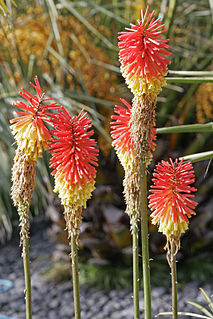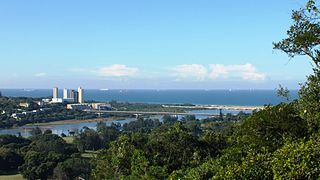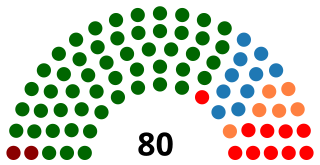Jozini | |
|---|---|
| Coordinates: 27°25′48″S32°04′01″E / 27.430°S 32.067°E Coordinates: 27°25′48″S32°04′01″E / 27.430°S 32.067°E | |
| Country | South Africa |
| Province | KwaZulu-Natal |
| District | Umkhanyakude |
| Municipality | Jozini |
| Area | |
| • Total | 4.16 km2 (1.61 sq mi) |
| Population (2011) [1] | |
| • Total | 2,267 |
| • Density | 540/km2 (1,400/sq mi) |
| Racial makeup (2011) | |
| • Black African | 90.6% |
| • Coloured | 0.3% |
| • Indian/Asian | 4.3% |
| • White | 3.2% |
| • Other | 1.6% |
| First languages (2011) | |
| • Zulu | 84.2% |
| • English | 5.8% |
| • Afrikaans | 1.9% |
| • Other | 8.1% |
| Time zone | UTC+2 (SAST) |
| PO box | 3969 |
| Area code | 035 |
Jozini is a settlement in Umkhanyakude District Municipality in the KwaZulu-Natal province of South Africa.

uMkhanyakude is the northernmost of the 11 districts of the KwaZulu-Natal province of South Africa. Its seat is Mkuze. It is a very rural district, the largest town being Mtubatuba in the south, with Hluhluwe, Mkuze, Jozini, Kwangwanase and Ingwavuma further to the north. The majority of its 573,353 people speak IsiZulu. The district code is DC27.

KwaZulu-Natal is a province of South Africa that was created in 1994 when the Zulu bantustan of KwaZulu and Natal Province were merged. It is located in the southeast of the country, enjoying a long shoreline beside the Indian Ocean and sharing borders with three other provinces and the countries of Mozambique, Eswatini and Lesotho. Its capital is Pietermaritzburg and its largest city is Durban. It is the 2nd most populous province in South Africa, with slightly fewer residents than Gauteng.

South Africa, officially the Republic of South Africa (RSA), is the southernmost country in Africa. It is bounded to the south by 2,798 kilometres (1,739 mi) of coastline of Southern Africa stretching along the South Atlantic and Indian Oceans; to the north by the neighbouring countries of Namibia, Botswana, and Zimbabwe; and to the east and northeast by Mozambique and Eswatini (Swaziland); and it surrounds the enclaved country of Lesotho. South Africa is the largest country in Southern Africa and the 25th-largest country in the world by land area and, with over 57 million people, is the world's 24th-most populous nation. It is the southernmost country on the mainland of the Old World or the Eastern Hemisphere. About 80 percent of South Africans are of Sub-Saharan African ancestry, divided among a variety of ethnic groups speaking different African languages, nine of which have official status. The remaining population consists of Africa's largest communities of European (White), Asian (Indian), and multiracial (Coloured) ancestry.
Jozini is a small town on the main route to Mozambique, and it is close to the Jozini or Pongolapoort Dam. Lake Jozini, as the dam is called, has become very popular as a Tiger fishing destination. [2]
Pongolapoort Dam, commonly referred to as Lake Jozini, is an arch type dam in northern KwaZulu-Natal, South Africa located on the Phongolo River. The dam is situated 280 km north-east of the port city of Durban. The dam was constructed in 1973 at the eastern end of the narrow gorge separating the Lebombo and Ubombo ranges and was the largest dam in South Africa at the time of its construction. The dam mainly serves for irrigation purposes and its hazard potential has been ranked high (3). The Phongolo River is the dams largest feeder as well as the dams only perennial feeder.














